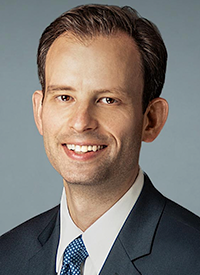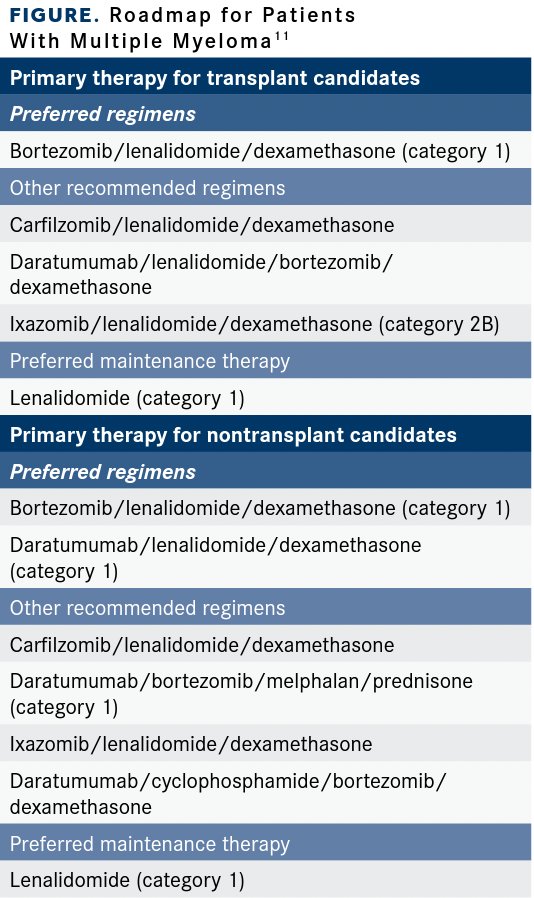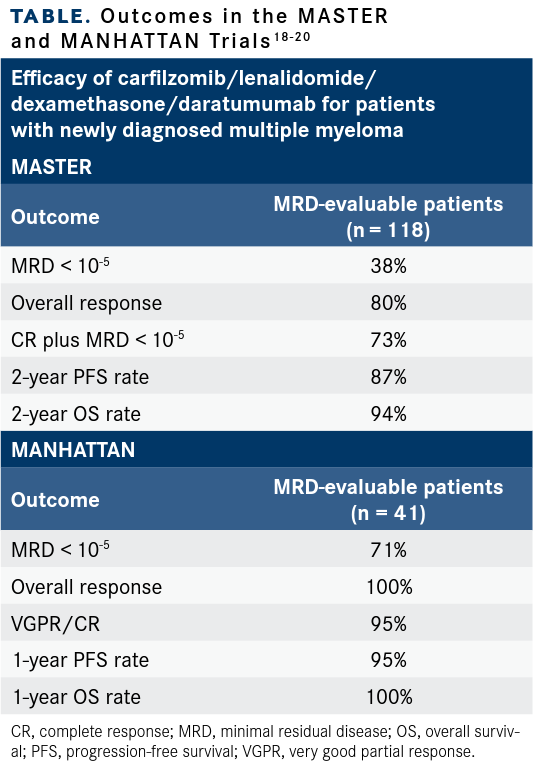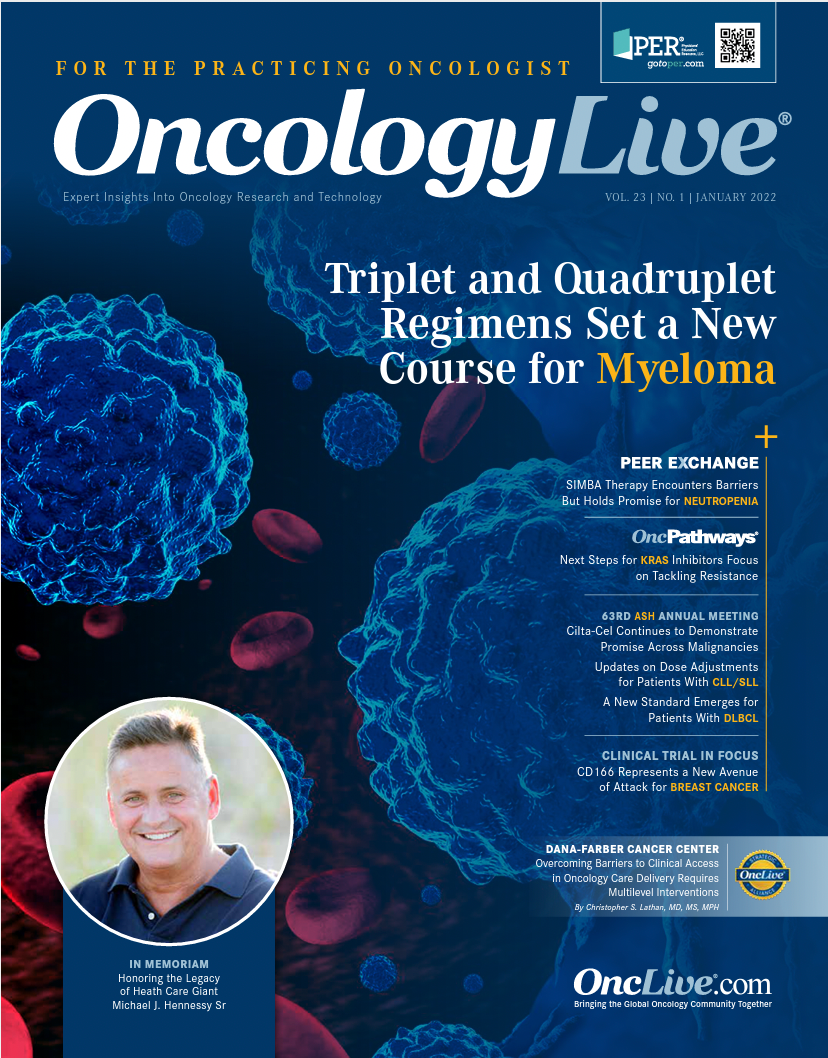Triplet and Quadruplet Regimens Set a New Course for Myeloma
When treating cancers that are considered generally incurable, such as multiple myeloma, one of the paradigms in oncology is to deliver the most effective therapies upfront to maximize the chances of prolonging remission.
Marc J. Braunstein, MD, PhD

When treating cancers that are considered generally incurable, such as multiple myeloma, one of the paradigms in oncology is to deliver the most effective therapies upfront to maximize the chances of prolonging remission. With the introduction of novel antimyeloma agents, including immunotherapies, that target specific elements of neoplastic plasma cells, we now have the opportunity to explore different combinations of potentially synergistic regimens with the aim of improving survival.1
Nevertheless, challenges remain in determin-ing the optimal regimen for newly diagnosed multiple myeloma (NDMM). These include personalizing treatment decisions based on molecular disease characteristics, overcoming poor prognostic features such as high-risk cytogenetics, and being able to achieve the absence of minimal residual disease (MRD) in a majority of patients.
Fortunately, with the expanding arsenal of agents available to treat patients with multiple myeloma, we are making strides in addressing some of these unmet needs.2
Developing a Course of Treatment
For the purposes of treatment planning, patients with NDMM have been historically separated into those who are eligible or ineligible for high-dose chemotherapy (ie, melphalan) and rescue with autologous stem cell transplant (ASCT), considering that high-dose chemotherapy can prolong survival compared with conventional therapies.3-5 As the eligibility criteria for ASCT has evolved beyond a simple age threshold to assessment of overall fitness,6 more patients are eligible and transplant-related mortal-ity remains low.7
Investigators of the random-ized phase 3 IFM/DFC12009 study (NCT01191060), compared induc-tion with bortezomib (Velcade; V), lenalidomide (Revlimid; R), and dexa-methasone—(VRd)—with or without consolidation with ASCT.3 In this study, 700 patients with NDMM with a median age of 59 years were enrolled. Results showed a 30% reduction in risk of progression with the inclusion of transplant; the median progression-free survival (PFS) was 47.3 months vs 35.0 months, respectively (HR, 0.70; P = .0001).8 Although there was no differ-ence in overall survival (OS), with more than 60% of patients alive in both arms at 8 years, 30% vs 20% of patients, respectively, achieved minimal residual disease (MRD) negativity with ASCT (P = .01).
The 3-drug VRd regimen remains a standard upfront regimen for NDMM; however, investi-gators have examined whether bortezomib or carfilzomib (Kyprolis; K) is a superior protea-some inhibitor (PI). For patients with NDMM with no intention to proceed to ASCT, the phase 3 ENDURANCE study (NCT01863550) compared VRd with KRd,9 and the phase 3 CLARION study (NCT01818752) compared bortezomib, melphalan, and prednisone (VMP) with KMP10; however, results of both studies failed to show a difference in PFS.
Adverse effects (AEs) were different between each arm, with higher rates of neuropathy associated with bortezo-mib and more cardiovascular AEs with carfilzomib, suggesting that at the least we can tailor the choice of upfront PI to individual patient morbidities.
Data from the phase 3 FORTE study (NCT02203643) lend support not only to upfront KRd but also to KR mainte-nance following transplant.5 In this study, 474 patients were randomized to one of 3 arms: KRd with ASCT, KRd without ASCT, or KCd with ASCT (with cyclophosphamide substituted for lenalidomide). Patients in all 3 arms received 4 cycles of induction therapy and 4 cycles of consolidation therapy, followed by a second randomization to either KR or R maintenance.
At a median follow-up of 45 months, patients in the KRd arms had superior outcomes to KCd, with a PFS rate of 78% (KRd + ASCT) vs 66% (KRd) vs 58% (KCd + ASCT). Likewise, at a median follow-up of 31 months from the second randomization, 81% vs 68% of patients were free from progression when comparing KR vs R maintenance (HR, 0.63; P = .026).
Using Triplet Regimens as Building Blocks
In the past few years, 4 monoclonal antibodies (mAbs) have been approved to treat patients with multiple myeloma. Initially these approvals were in the relapsed/refractory setting. More recently, the use of the anti-CD38 mAb daratumumab (Darzalex) has moved to the upfront setting and has been incorporated into guidelines as part of triplet and quadruplet induction regimens (FIGURE).11
FIGURE. Roadmap for Patients With Multiple Myeloma

Building on the success of a 3-drug regimen for patients with NDMM, results of 3 randomized studies have demonstrated a benefit of adding daratumumab upfront to either VMP (ALCYONE [NCT02195479]12), bortezomib, thalidomide, and prednisone (VTP; Cassiopeia [NCT02541383]13), or VRd (GRIFFIN [NCT02874742]14).
Alcyone
The combination of D-VMP was approved based on findings from the phase 3 ALCYONE study which demonstrated both a PFS and an OS improvement in patients with NDMM who are ineligible for ASCT.12 At a median follow-up of 40 months, the median PFS was 36 months with D-VMP vs 19 months with VMP (HR, 0.42; 95% CI, 0.34-0.51; P < .0001). The 36-month OS rate was 78.0% (95% CI, 73.2%-82.0%) vs 67.9% (95% CI, 62.6%-72.6%), favoring D-VMP.
As is common in these studies, the primary AE associated with the addition of daratumumab is myelosuppression. The rate of grade 3 or 4 infections was slightly higher in the daratumumab-containing arm at 22% vs 15%, respectively. However, the discontinuation rate trended lower with the 4-drug regimen.
Griffin
For patients with transplant eligible–NDMM, results from both the CASSIOPEIA (D-VTD) and GRIFFIN (D-VRD) studies have shown improvement in depth of response, including the achievement of absence of MRD.13,14
In the randomized phase 2 GRIFFIN study, 207 patients with NDMM were randomized to receive either D-VRd or VRd followed by ASCT. Patients in both arms continued to receive maintenance with either lenalidomide plus daratumumab or lenalidomide alone. There was no second randomization, and participants remained in their respective arms. The primary end point was stringent complete response (sCR).
Results showed that the inclusion of daratumumab did not affect the procession to ASCT, but more individuals needed more agents to facilitate peripheral blood stem cell mobilization. At a median follow-up of 22 months, 99.0% vs 91.8% had achieved a response (OR, 8.75; 95% CI, 1.08-71.01; P = .016), with more patients achieving sCR (42.4% vs 32.0%, respectively) and MRD negativity at 10-5 (51% vs 20%) with the addition of daratumumab. Although less than 20% of patients were high risk, there did not appear to be a difference in sCR in the subgroup, and the study is still maturing in terms of PFS and OS analyses.
Clearly the balance of efficacy and toxicity favors the addition of daratumumab to upfront treatment of patients with multiple myeloma. Ongoing studies are evaluating the long-term benefit on OS in those with transplanteligible NDMM.
Transplant-Ineligible Patients
For patients who are transplant-ineligible, investigators of the phase 3 MAIA study (NCT02252172) compared D-Rd with Rd alone in 737 patients with NDMM.15 Recently updated data showed that at a median follow-up of 56 months the 5-year OS rate was 66% vs 53% (HR, 0.68, P = .0013) favoring D-Rd. The median time to next treatment was not reached vs 42.4 months, respectively (HR, 0.47; P < .0001).16
Although we lack data comparing D-Rd with VRd in patients who are transplant ineligible, data from both MAIA (D-Rd)16 and SWOG S0777 (VRd; NCT00644228)17 demonstrated a survival benefit with 3-drug induction regimens compared with their respective 2-drug control arms. This resulted in a category 1 recommendation from the National Comprehensive Cancer Network for both regimens.11
The phase 3 CEPHEUS (NCT03652064) and PERSEUS (NCT03710603) studies are examining the role of D-VRd in this population.
Future Directions
Ongoing studies are examining the role of mAb-based combination regimens for NDMM. For example, 2 single-arm phase 2 studies, MASTER (NCT03224507)18 and MANHATTAN,19 investigated the combination of D-KRd with or without ASCT, respectively (TABLE18-20).
TABLE. Outcomes in the MASTER and MANHATTAN Trials

In the MASTER trial, 81 patients received 4 cycles of D-KRd induction followed by ASCT and MRD-guided consolidation and maintenance R (patients who became MRD-negative entered a treatment-free observation phase). Results of this study showed that an impressive 95% of patients achieved sCR at MRD-based consolidation. In the ongoing phase 2 ADVANCE trial (NCT04268498), investigators are comparing D-KRd vs KRd for patients with NDMM.
In summary, significant progress has been made with novel antimyeloma regimens that include the use of mAbs with or without consolidation with ASCT. Multiple studies are being conducted or conceived to address other important questions, including how to best manage high-risk patients; whether there will be a benefit observed with the addition of novel antibodies with induction, such as the antiBCMA antibody-drug conjugate belantamab mafodotin-blmf (Blenrep); and if there is a role for earlier incorporation of chimeric antigen receptor T cells in the consolidation phase. The 5-year survival rate for multiple myeloma has risen by nearly 10% over the past decade, and is now at a 56%, largely due to novel agents and their combinations.21 Over the next decade we will likely see the number continue to rise as survival improves.22
References




